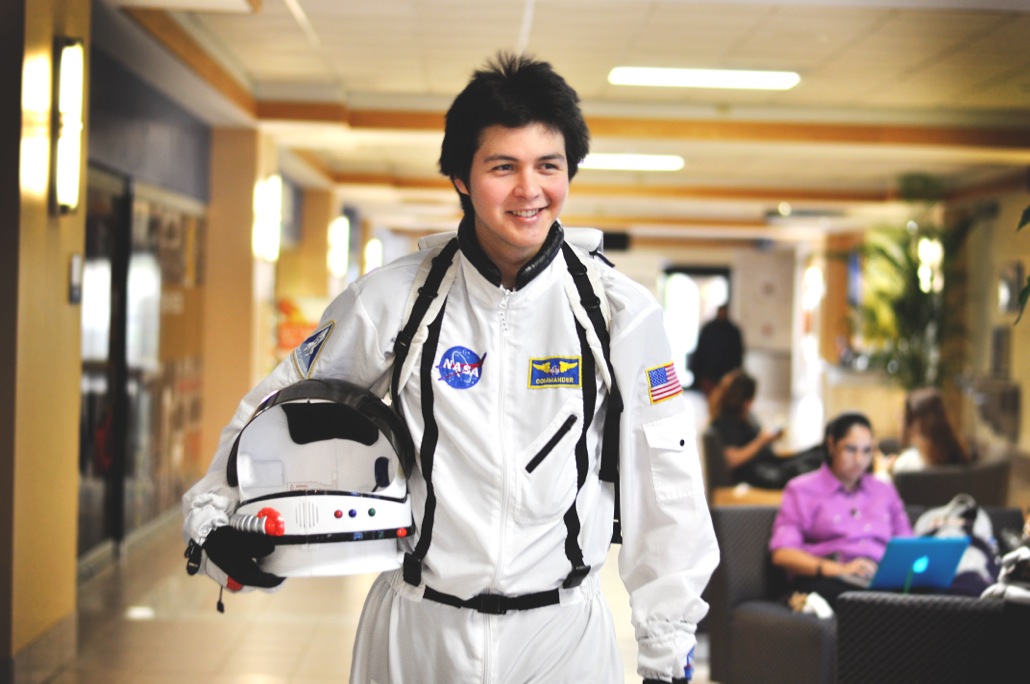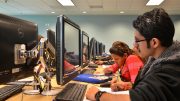Featured image by Sana Ullah.
[soundcloud url=”https://api.soundcloud.com/tracks/129410039″ params=”color=ff6600&auto_play=false&show_artwork=true” width=”100%” height=”166″ iframe=”true” /]
Madison Fantozzi/News Director

Patrick Ford, junior physics major and astronomy and geology minor, was selected in late December by Mars One to move on to its second round in a search for 24 astronauts to settle on the red planet. Stephanie Mason/FIU Student Media
Patrick Ford may have crashed his silver 2001 Camaro last week, but he also found out that by 2025 he may be trading his car in for a spaceship to Mars.
The junior physics major minoring in astronomy and geology applied in April for the Mars One project along with over 200,000 people worldwide. The applicant pool–slashed by 95 percent–now includes 1,058 candidates who will move on to the project’s second round of medical examinations, simulations and personal interviews.
“I’m very passionate and I think I can bring a lot to the table,” Ford said. “I can’t think of anything I’d rather do.”
Mars One is a not-for-profit that plans to establish a human settlement of 24 astronauts on the planet in 2025.
Five key characteristics of an astronaut were outlined at the start of the application process: resilience, adaptability, curiosity, the ability to trust, and creativity and resourcefulness.
“I tried to gear my answers to my reflection of those qualities,” Ford said. “But I think my passion is what really gives me that extra push.”
Ford noted that the Mars One application didn’t emphasize science more than it did humility. Applicants were not required to have a scientific background or degree.
The second round is projected to last through the rest of 2014, including a medical examination. Ford received an extensive checklist.
Examinations need to be completed by March, and then applicants will receive information about simulation testing and personal interviews.
“Organ systems need to be in check and we need to be free of diseases,” Ford said. “The idea is that we are supposed to be as healthy as possible so we don’t have to bring anything extra on the mission because that would be wasted mass.”
Budgeting mass also means this mission is a one-way ticket to the red planet.
“This trip is nonrefundable,” Ford joked.
According to Ford, missions that call for a return trip are almost double the cost.

Ford sports an astronaut costume on campus, carries a rock from the asteroid belt in his pocket and has galaxy-inspired ink. The space buff hopes to travel to Mars as early as 2025. Stephanie Mason/FIU Student Media
“If we had to come back, we would have to send a return vehicle there–added mass. Then we have to send the fuel there, unless you go with a design that can extract fuel from the ground itself. You have to provide food, water and resources for another seven to eight month return trip,” he said.
The project’s timeline has already been pushed back two years and includes sending synchronized satellites, hydraulic rovers and a smart lander in 2018 to determine where the astronauts should settle, linking up modules and creating a solar-paneled power supply.
The first team will be responsible for maintenance, construction and preparation for the next group of people, as well as scientific research.
“The rovers are basically like geologists. As amazing as they are, a human can do what they can do in an entire day in a couple of minutes,” Ford said. “Our ability to do hands-on research and science on the surface will tremendously increase with a human presence.”
Ford has two concerns for the mission–physical adjustments and psychological stressors–with a focus on the latter.
“The biggest problems lay in the psychique. The people who went to the moon they knew they were coming back in a couple of days. If you talk about someone who is going to be gone from their planet for forever, that’s something that’s a little bit new,” Ford said.
“But there are people who have left their homes and knew they would never return and they were okay. They adapted to a new life and new circumstances. I would say the biggest problems lay in our minds of those who are going.”
Physical adjustment to the planet is a secondary problem to Ford, who says inertial exercises will simulate what gravity would do to the body on Earth to keep muscle mass and bone density strong.
Ford is also concerned about adjusting to a crammed lifestyle. “It’ll be like cabin fever,” he joked.
“But we’re doing something that has never been done before,” Ford said. “In this journey we’d be going further than any human has gone before by a long shot.”
You can follow Ford’s journey on Facebook at https://www.facebook.com/patrickthemartian
Assistant news director Jeffrey Pierre contributed to this report.
– madison.fantozzi@fiusm.com






Be the first to comment on "Panther makes first cut for Mars One mission"